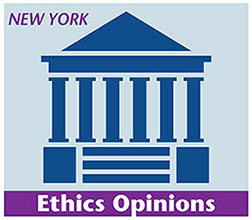Protecting Your Fees: The Ethics of Fee Claims (at Frankfurt Kurnit’s 2019 Litigation Ethics Summit)
 The first panel of the day focused on how fee disputes arise and how those disputes affect malpractice claims under New York law. The panel featured plaintiff malpractice attorney Daniel Abrams, ALAS Vice President—Senior Claims Counsel Kenneth Small, and Frankfurt Kurnit’s Ron Minkoff and Richard Maltz. Among other things, the group covered:
The first panel of the day focused on how fee disputes arise and how those disputes affect malpractice claims under New York law. The panel featured plaintiff malpractice attorney Daniel Abrams, ALAS Vice President—Senior Claims Counsel Kenneth Small, and Frankfurt Kurnit’s Ron Minkoff and Richard Maltz. Among other things, the group covered:
- How engagement letter scope-of-representation language can lead to exposure
- Whether there are limits on contingency fees
- Midstream changes in fee arrangements
- Referral fees; and
- Remedies for recovering your fee
Here’s a brief summary of some of the points the panel discussed.
Scope of representation.
Unclear or over-broad retainer letter scope-of-representation language can create many issues. For example, the panel urged attorneys to be clear on what substantive areas of the law will be handled during the engagement; who is responsible for assessing insurance coverage and notifying the carrier about claims; and who will be responsible for appeals.
Dan Abrams noted that while a broad scope of retainer may lead to more business, “retentions based on the unilateral request of the client are problematic.” Attorneys need to consider that there may be conflicts later, and that the attorney or firm may not have the necessary expertise to handle a client request.
Ken Small urged attorneys to have a new engagement letter for every new matter. “Even if potential fees on small matters seem not to justify new engagement letters every time, remember that the malpractice case may be for several million dollars.” Small urged the audience to:
1) Make sure your retainer agreement limits the scope of your representation;
2) Practice in accordance with your retainer agreement;
3) If insurance is within the scope of your representation, make sure you understand insurance issues, or hire someone who does; and
4) Document in writing all advice to the client
Appeals can create exposure – particularly in cases where there is a large fee receivable and the attorney would prefer not to handle post-trial work. The panel urged the audience to consider that the client may need time to find appellate counsel. State court appellate practice offers more flexibility than federal court practice (with federal judges less likely, in general, to let a lawyer out of a case). Attorneys must also weigh the relative sophistication of their clients when communicating the strategy for switching counsel for an appeal.
Takeaway: Talk to the client about potential appeals before the end of the trial. If you’re not inclined to do the appeal, explain—in writing—that the client will need a back-up plan. Richard Maltz suggested that the initial retainer clearly state that the attorney will not handle the appeal absent a new agreement. Either way, clear advance communication, in writing, will weaken an unhappy client’s argument that you should not receive your fee because you left the client with insufficient time to find appellate counsel.
Contingency fee arrangements.
The panel discussed whether there are limits to how much an attorney can receive in a contingency arrangement.
Ron Minkoff noted that there are very few cases holding that a fee was unconscionably excessive. Still, he explained, the burden is on the lawyer to satisfy a two-part test to show that the fee was procedurally and substantively fair. Procedural fairness means that the attorney and client negotiated the fee agreement at arms length, and the attorney did not place undue pressure on, or defraud, the client. Substantive fairness means that the fee was not excessive for the type and amount of work being done.
The panel focused on specific arrangements. Richard Maltz noted that “There is nothing improper about a taking more than 1/3 of a recovery, but doing so will raise red flags with judges.” He added that “you may be allowed to take 55% of the recovery as your fee, but you probably shouldn’t,” as courts are skeptical when lawyers receive a higher percentage of a recovery than the client receives.
Midstream changes in fee arrangements. The panel focused on what happens when a lawyer restructures her fee arrangement midstream–e.g., from an hourly to a contingency arrangement – and there’s a windfall for the lawyer.
Maltz noted that “midstream modifications are problematic and discouraged.” The key question in the subsequent fee battle is going to be: what did the firm know before changing the arrangement? Did the firm know, for example, that critical evidence would come to light after the fee arrangement changed? Minkoff: “There’s a presumption that a midstream change will be favorable to the lawyer and a possible breach of a fiduciary duty; the burden will be on the lawyer to show the modification was fair.”
Takeaway: If you’re going to modify a fee arrangement during the pendency of a case, make sure the client understands the risks and advantages of the change. Urge the client to consult independent counsel. And, as always, consider the sophistication of the client.
Referral fees.
The panel discussed whether a referring attorney could receive a fee despite performing little or no work, and how state and federal courts differ in their analysis of referral fee fairness. “Generally, federal courts do not favor referral fees,” said Richard Maltz, adding that state courts are more likely to permit them. Dan Abrams urged attorneys to let their clients know when a referring attorney is receiving a fee, and how that fee will be determined, or else risk violating Rule 1.5(g).
Remedies for recovering your fee.
The panel concluded with a rundown of three methods for pursuing fees from clients:
- Retaining liens – where the lawyer retains the file until paid or the client puts up a bond;
- Charging liens – where the lawyer receives a statutory percentage of judgment or settlement proceeds; and
- Plenary fee actions – which, the panel noted, are usually based on quantum meruit.
Related Posts
« How to Lose Your Legal Fee, Part 3: Fee Disputes with Clients in Federal Court Aggressive Bargaining: The Legal and Ethical Boundaries of “Me Too”-era Settlements (at Frankfurt Kurnit’s Litigation Ethics Summit) »











